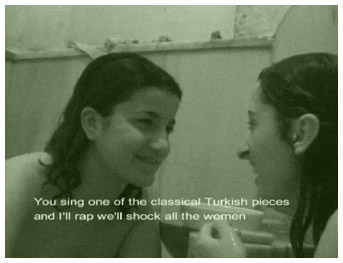


 |


launch interview with Ersen
Esra Ersen explores social behavior--the way identities are shaped and transformed across national, cultural, linguistic, and intimate borders. Whether working in photography, video, or installation, she often reacts to or uses the specific location of her activity in order to formalize her investigations. In a programmatic way, Ersen is analyzing how society administrates the different layers, tensions, and contradictions of its own construct. With serene subversion, her work is based on an empirical and analytical study of social situations through culture, myths, ritual, and economy. She applies a methodology of microevents borrowed from documentary film-making or from anthropological investigation.
In If You Could Speak Swedish (2001), the artist collaborated with a class of new immigrants studying Swedish in a school outside of Stockholm. She asked the students to write down, in their native language, what they would like to express if they could speak Swedish. The answers ranged from very personal, emotional expressions to political statements. The responses were translated into Swedish and the students were asked to read them in front of a camera. The participants' varying degrees of difficulty with the spoken words are visualized through body language. Ersen challenges the notion of a dominant language by showing the capacity of immigrants to master it. And she raises the issue of the subaltern voice when she asks immigrants--refugees of Chinese, Arabic, Russian, Spanish, and Bengali descent--to express their feelings in their "host" language. Shown at the Moderna Museet in Stockholm, this work was also on display in a legendary Kebab restaurant in the city. Through these two presentations, Ersen provided two different "readings" of the same images, based on the distinct and opposing contexts: a major Western art institution that establishes cultural orthodoxy and canons and the vernacular milieu of an ethnic restaurant.
In her search for an alternative to the official voice, Ersen also explores the value of small talk. She examines the in-between quality of such conversations, which stand somewhere between the intimate and the pedestrian, the public and the private. In her video installation Hamam (2001), she conceived and provided a viewing room that made available to the audience a traditionally gender-exclusive space in which two women are partaking in endless, careless chitchat about everything and nothing. What begins as a casual conversation piece ends up being a critical consideration of the social space created by interpersonal communication. It is a space where, in this case, a private moment is bouncing into the display of public selves, where intimacy is broken and exposed to the audience's indiscreet and inquisitive gaze.
Ersen's work has appeared in numerous group exhibitions, including Manifesta 4, Frankfurt, Germany (2002); the Gwangju Biennale, South Korea (2002); Turkish Contemporary Art, Kunstmuseum Bonn, Germany (2002); Becoming a Place, Proje4L Istanbul Museum of Contemporary Art, Turkey (2001); and Dare to Be Different, Cultural Center Linda Art, Fier, Albania (2001). The Moderna Museet in Stockholm, Sweden, organized a solo exhibition of her work in 2002.
--Philippe Vergne











